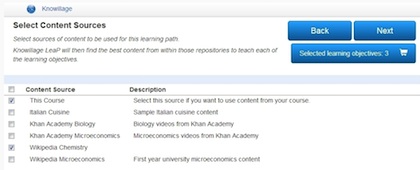Desire2Learn 'Supercharges' Personalized Learning with Knowillage Purchase
- By Dian Schaffhauser
- 09/09/13
Education technology company Desire2Learn has acquired a startup with a program that enables instructors to personalize the selection of digital learning resources through an automated process. The company has purchased British Columbia-based Knowillage Systems for an undisclosed amount.
Knowillage, which consists of a handful of software engineers who had previously done work for companies such as WebCT (now subsumed into Blackboard) and Pearson Education, will remain in the Vancouver area and become Desire2Learn's adaptive learning headquarters, according to Jeff McDowell, vice president of marketing and business development.
The Knowillage team created a program called LEArning Path (LeaP), which can be added to a learning management system (LMS) and provides a wizard that the teacher or faculty member can use to personalize the learning paths for each student in a course. LeaP uses language processing and analytics to determine gaps in a student's skill set and then provides a list of additional content, exercises, and assessment material to help the student get back on track. Those resources can be provided by the educator, culled from publisher content, or discovered in open educational resources from trusted Internet collections. The adaptive learning engine in Knowillage combs these sources to find, analyze, select, and suggest the best learning activities based on language and context to create adaptive learning paths for each student.
| |

LeaP allows instructors to provide their own resources or those discovered in open educational resources from trusted Internet collections. |
|
"We've always had a vision for building learning environments that can tailor towards the individual. And the acquisition of Knowillage supercharges that," said McDowell. "The reason why we're so excited about this particular acquisition is because the other stuff we've seen in the market for adaptive learning has been very expensive and complicated and manual and time intensive to set up."
According to Knowillage founder and CEO Bill Bilic, "If your LMS is configured with your library, your course content, anything, we make sure that we establish what we call a 'web of education' relationship — something more meaningful than just keywords. And with that knowledge we map that to your outcomes inside of your course. That's pretty much it." As long as a learning object "can be rendered through the browser" and has a uniform resource identifier, he added, it can be used as a possible resource.
Bilic said LeaP is based on the Learning Tools Interoperability specification, a standard developed through IMS Global that allows an LMS or other learning environment to present content or other applications to the user. LeaP can be deployed at the course level, school level, or more broadly.
When an instructor creates an instance of a learning path, the program shows a list of potential repositories available to that teacher as possible learning resources. He or she picks the ones relevant to that set of learners.
As the system is used more and more, said Bilic, the analytics engine in LeaP also takes into account data generated about student and content activity — "what's good, what is not, what sticks out, what doesn't."
McDowell said Knowillage first came to the attention of Desire2Learn about six months ago when the two companies worked together to integrate LeaP into Desire2Learn's LMS. Earlier this year, the company introduced a version of LeaP that integrates with Canvas from Instructure.
The technology will continue to be available for Canvas as well as other learning systems, McDowell said. "We will continue to keep it open and integrate it with other LMSs."
About the Author
Dian Schaffhauser is a former senior contributing editor for 1105 Media's education publications THE Journal, Campus Technology and Spaces4Learning.